torque FIAT DOBLO COMBI 2018 Owner handbook (in English)
[x] Cancel search | Manufacturer: FIAT, Model Year: 2018, Model line: DOBLO COMBI, Model: FIAT DOBLO COMBI 2018Pages: 272, PDF Size: 23.75 MB
Page 80 of 272
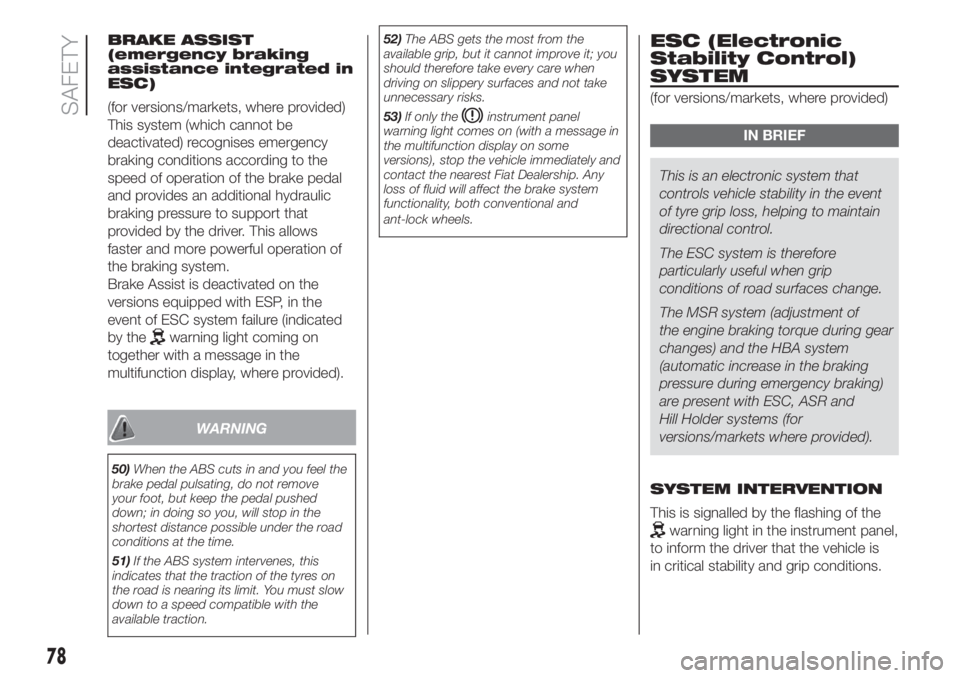
BRAKE ASSIST
(emergency braking
assistance integrated in
ESC)
(for versions/markets, where provided)
This system (which cannot be
deactivated) recognises emergency
braking conditions according to the
speed of operation of the brake pedal
and provides an additional hydraulic
braking pressure to support that
provided by the driver. This allows
faster and more powerful operation of
the braking system.
Brake Assist is deactivated on the
versions equipped with ESP, in the
event of ESC system failure (indicated
by the
warning light coming on
together with a message in the
multifunction display, where provided).
WARNING
50)When the ABS cuts in and you feel the
brake pedal pulsating, do not remove
your foot, but keep the pedal pushed
down; in doing so you, will stop in the
shortest distance possible under the road
conditions at the time.
51)If the ABS system intervenes, this
indicates that the traction of the tyres on
the road is nearing its limit. You must slow
down to a speed compatible with the
available traction.52)The ABS gets the most from the
available grip, but it cannot improve it; you
should therefore take every care when
driving on slippery surfaces and not take
unnecessary risks.
53)If only the
instrument panel
warning light comes on (with a message in
the multifunction display on some
versions), stop the vehicle immediately and
contact the nearest Fiat Dealership. Any
loss of fluid will affect the brake system
functionality, both conventional and
ant-lock wheels.
ESC (Electronic
Stability Control)
SYSTEM
(for versions/markets, where provided)
IN BRIEF
This is an electronic system that
controls vehicle stability in the event
of tyre grip loss, helping to maintain
directional control.
The ESC system is therefore
particularly useful when grip
conditions of road surfaces change.
The MSR system (adjustment of
the engine braking torque during gear
changes) and the HBA system
(automatic increase in the braking
pressure during emergency braking)
are present with ESC, ASR and
Hill Holder systems (for
versions/markets where provided).
SYSTEM INTERVENTION
This is signalled by the flashing of the
warning light in the instrument panel,
to inform the driver that the vehicle is
in critical stability and grip conditions.
78
SAFETY
Page 81 of 272
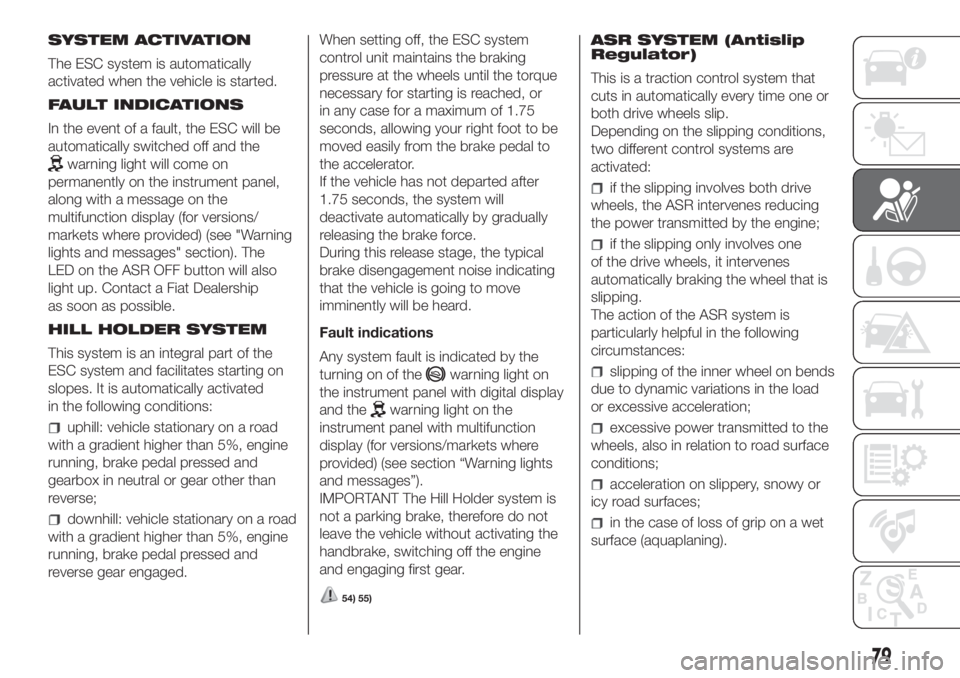
SYSTEM ACTIVATION
The ESC system is automatically
activated when the vehicle is started.
FAULT INDICATIONS
In the event of a fault, the ESC will be
automatically switched off and the
warning light will come on
permanently on the instrument panel,
along with a message on the
multifunction display (for versions/
markets where provided) (see "Warning
lights and messages" section). The
LED on the ASR OFF button will also
light up. Contact a Fiat Dealership
as soon as possible.
HILL HOLDER SYSTEM
This system is an integral part of the
ESC system and facilitates starting on
slopes. It is automatically activated
in the following conditions:
uphill: vehicle stationary on a road
with a gradient higher than 5%, engine
running, brake pedal pressed and
gearbox in neutral or gear other than
reverse;
downhill: vehicle stationary on a road
with a gradient higher than 5%, engine
running, brake pedal pressed and
reverse gear engaged.When setting off, the ESC system
control unit maintains the braking
pressure at the wheels until the torque
necessary for starting is reached, or
in any case for a maximum of 1.75
seconds, allowing your right foot to be
moved easily from the brake pedal to
the accelerator.
If the vehicle has not departed after
1.75 seconds, the system will
deactivate automatically by gradually
releasing the brake force.
During this release stage, the typical
brake disengagement noise indicating
that the vehicle is going to move
imminently will be heard.
Fault indications
Any system fault is indicated by the
turning on of the
warning light on
the instrument panel with digital display
and the
warning light on the
instrument panel with multifunction
display (for versions/markets where
provided) (see section “Warning lights
and messages”).
IMPORTANT The Hill Holder system is
not a parking brake, therefore do not
leave the vehicle without activating the
handbrake, switching off the engine
and engaging first gear.
54) 55)
ASR SYSTEM (Antislip
Regulator)
This is a traction control system that
cuts in automatically every time one or
both drive wheels slip.
Depending on the slipping conditions,
two different control systems are
activated:
if the slipping involves both drive
wheels, the ASR intervenes reducing
the power transmitted by the engine;
if the slipping only involves one
of the drive wheels, it intervenes
automatically braking the wheel that is
slipping.
The action of the ASR system is
particularly helpful in the following
circumstances:
slipping of the inner wheel on bends
due to dynamic variations in the load
or excessive acceleration;
excessive power transmitted to the
wheels, also in relation to road surface
conditions;
acceleration on slippery, snowy or
icy road surfaces;
in the case of loss of grip on a wet
surface (aquaplaning).
79
Page 82 of 272
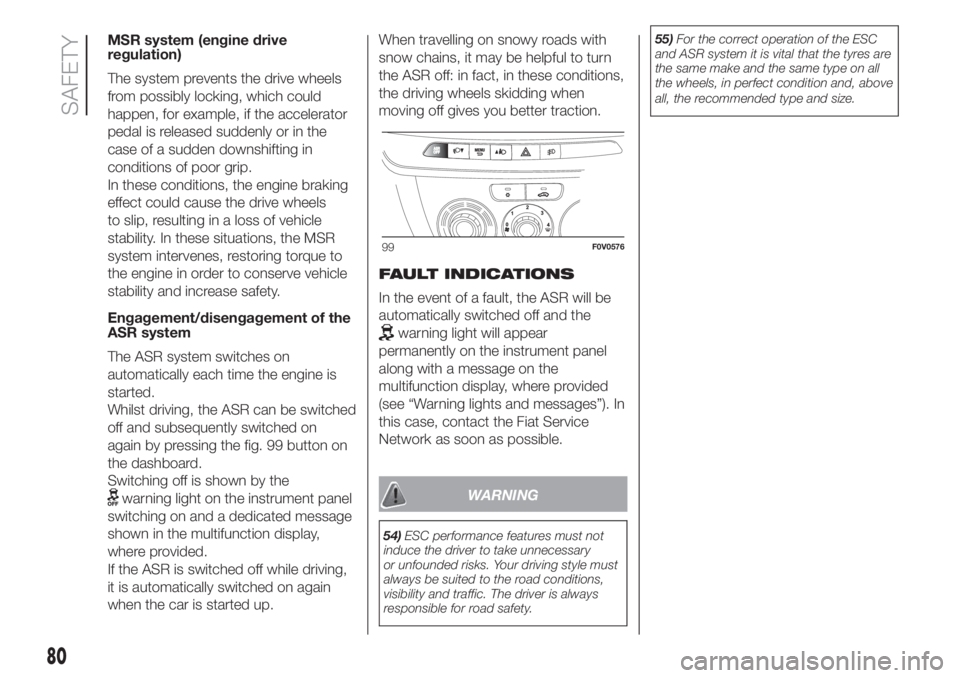
MSR system (engine drive
regulation)
The system prevents the drive wheels
from possibly locking, which could
happen, for example, if the accelerator
pedal is released suddenly or in the
case of a sudden downshifting in
conditions of poor grip.
In these conditions, the engine braking
effect could cause the drive wheels
to slip, resulting in a loss of vehicle
stability. In these situations, the MSR
system intervenes, restoring torque to
the engine in order to conserve vehicle
stability and increase safety.
Engagement/disengagement of the
ASR system
The ASR system switches on
automatically each time the engine is
started.
Whilst driving, the ASR can be switched
off and subsequently switched on
again by pressing the fig. 99 button on
the dashboard.
Switching off is shown by the
warning light on the instrument panel
switching on and a dedicated message
shown in the multifunction display,
where provided.
If the ASR is switched off while driving,
it is automatically switched on again
when the car is started up.When travelling on snowy roads with
snow chains, it may be helpful to turn
the ASR off: in fact, in these conditions,
the driving wheels skidding when
moving off gives you better traction.
FAULT INDICATIONS
In the event of a fault, the ASR will be
automatically switched off and the
warning light will appear
permanently on the instrument panel
along with a message on the
multifunction display, where provided
(see “Warning lights and messages”). In
this case, contact the Fiat Service
Network as soon as possible.
WARNING
54)ESC performance features must not
induce the driver to take unnecessary
or unfounded risks. Your driving style must
always be suited to the road conditions,
visibility and traffic. The driver is always
responsible for road safety.55)For the correct operation of the ESC
and ASR system it is vital that the tyres are
the same make and the same type on all
the wheels, in perfect condition and, above
all, the recommended type and size.
99F0V0576
80
SAFETY
Page 108 of 272
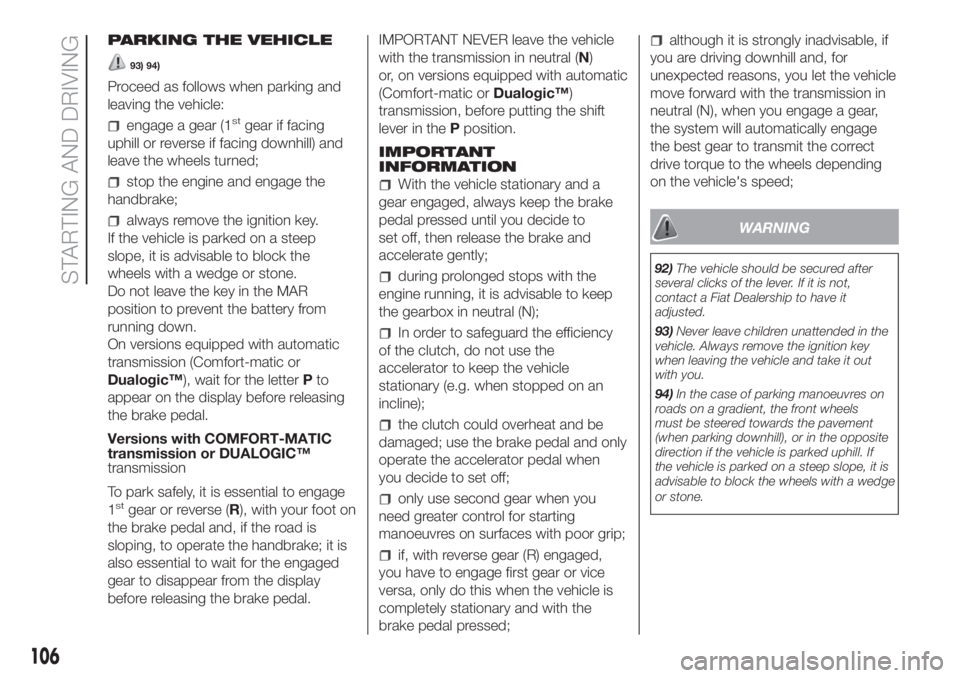
PARKING THE VEHICLE
93) 94)
Proceed as follows when parking and
leaving the vehicle:
engage a gear (1stgear if facing
uphill or reverse if facing downhill) and
leave the wheels turned;
stop the engine and engage the
handbrake;
always remove the ignition key.
If the vehicle is parked on a steep
slope, it is advisable to block the
wheels with a wedge or stone.
Do not leave the key in the MAR
position to prevent the battery from
running down.
On versions equipped with automatic
transmission (Comfort-matic or
Dualogic™), wait for the letterPto
appear on the display before releasing
the brake pedal.
Versions with COMFORT-MATIC
transmission or DUALOGIC™
transmission
To park safely, it is essential to engage
1
stgear or reverse (R), with your foot on
the brake pedal and, if the road is
sloping, to operate the handbrake; it is
also essential to wait for the engaged
gear to disappear from the display
before releasing the brake pedal.IMPORTANT NEVER leave the vehicle
with the transmission in neutral (N)
or, on versions equipped with automatic
(Comfort-matic orDualogic™)
transmission, before putting the shift
lever in thePposition.
IMPORTANT
INFORMATION
With the vehicle stationary and a
gear engaged, always keep the brake
pedal pressed until you decide to
set off, then release the brake and
accelerate gently;
during prolonged stops with the
engine running, it is advisable to keep
the gearbox in neutral (N);
In order to safeguard the efficiency
of the clutch, do not use the
accelerator to keep the vehicle
stationary (e.g. when stopped on an
incline);
the clutch could overheat and be
damaged; use the brake pedal and only
operate the accelerator pedal when
you decide to set off;
only use second gear when you
need greater control for starting
manoeuvres on surfaces with poor grip;
if, with reverse gear (R) engaged,
you have to engage first gear or vice
versa, only do this when the vehicle is
completely stationary and with the
brake pedal pressed;
although it is strongly inadvisable, if
you are driving downhill and, for
unexpected reasons, you let the vehicle
move forward with the transmission in
neutral (N), when you engage a gear,
the system will automatically engage
the best gear to transmit the correct
drive torque to the wheels depending
on the vehicle's speed;
WARNING
92)The vehicle should be secured after
several clicks of the lever. If it is not,
contact a Fiat Dealership to have it
adjusted.
93)Never leave children unattended in the
vehicle. Always remove the ignition key
when leaving the vehicle and take it out
with you.
94)In the case of parking manoeuvres on
roads on a gradient, the front wheels
must be steered towards the pavement
(when parking downhill), or in the opposite
direction if the vehicle is parked uphill. If
the vehicle is parked on a steep slope, it is
advisable to block the wheels with a wedge
or stone.
106
STARTING AND DRIVING
Page 117 of 272
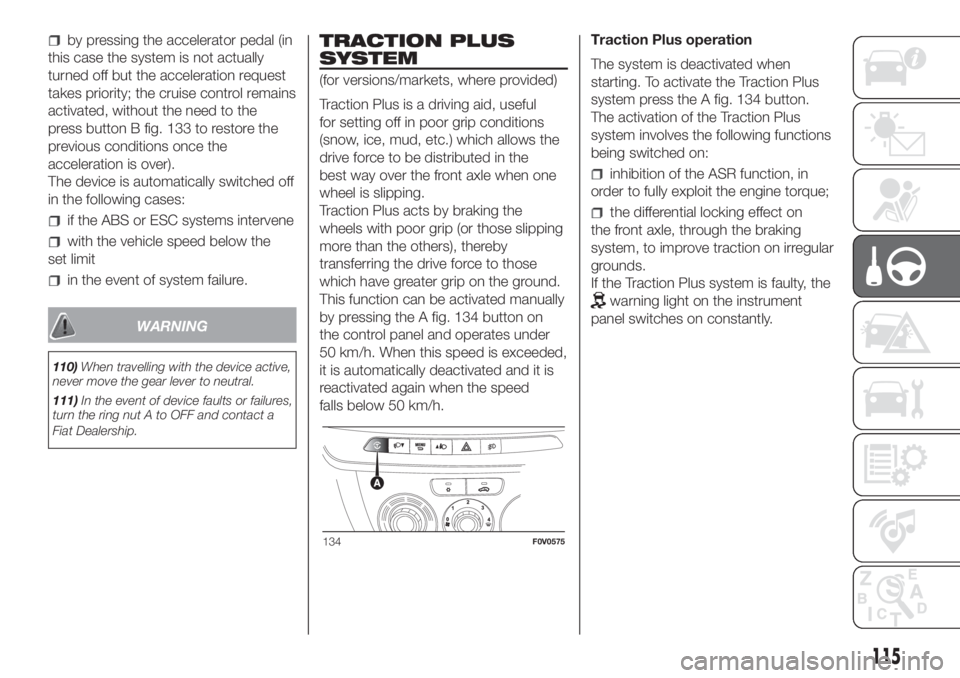
by pressing the accelerator pedal (in
this case the system is not actually
turned off but the acceleration request
takes priority; the cruise control remains
activated, without the need to the
press button B fig. 133 to restore the
previous conditions once the
acceleration is over).
The device is automatically switched off
in the following cases:
if the ABS or ESC systems intervene
with the vehicle speed below the
set limit
in the event of system failure.
WARNING
110)When travelling with the device active,
never move the gear lever to neutral.
111)In the event of device faults or failures,
turn the ring nut A to OFF and contact a
Fiat Dealership.
TRACTION PLUS
SYSTEM
(for versions/markets, where provided)
Traction Plus is a driving aid, useful
for setting off in poor grip conditions
(snow, ice, mud, etc.) which allows the
drive force to be distributed in the
best way over the front axle when one
wheel is slipping.
Traction Plus acts by braking the
wheels with poor grip (or those slipping
more than the others), thereby
transferring the drive force to those
which have greater grip on the ground.
This function can be activated manually
by pressing the A fig. 134 button on
the control panel and operates under
50 km/h. When this speed is exceeded,
it is automatically deactivated and it is
reactivated again when the speed
falls below 50 km/h.Traction Plus operation
The system is deactivated when
starting. To activate the Traction Plus
system press the A fig. 134 button.
The activation of the Traction Plus
system involves the following functions
being switched on:
inhibition of the ASR function, in
order to fully exploit the engine torque;
the differential locking effect on
the front axle, through the braking
system, to improve traction on irregular
grounds.
If the Traction Plus system is faulty, the
warning light on the instrument
panel switches on constantly.
134F0V0575
115
Page 150 of 272
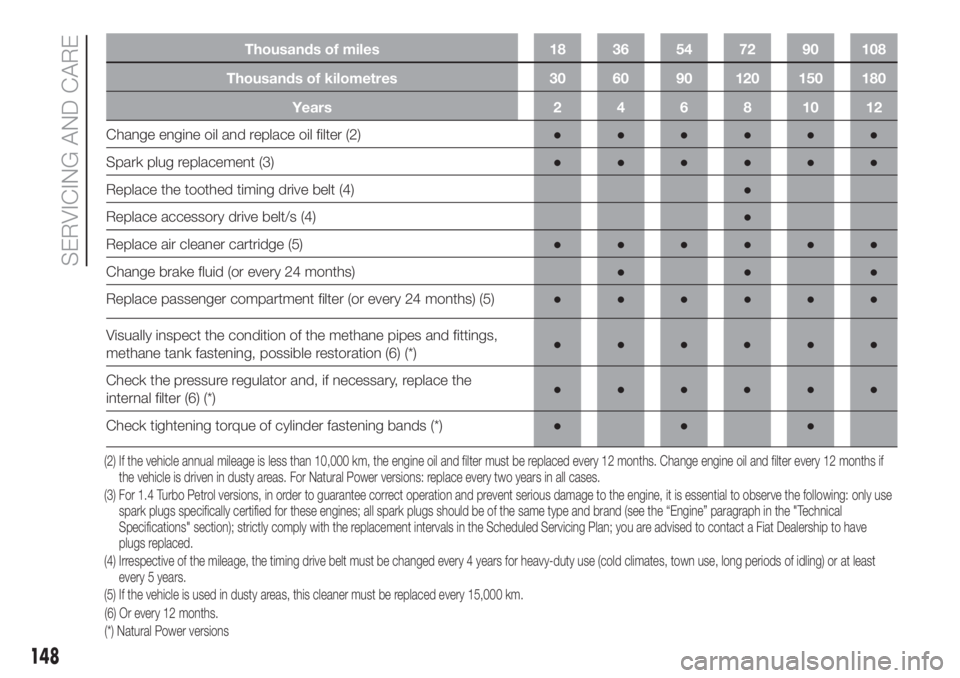
148
SERVICING AND CARE
Thousands of miles 18 36 54 72 90 108
Thousands of kilometres 30 60 90 120 150 180
Years 2 4 6 8 10 12
Change engine oil and replace oil filter (2)●●●●●●
Spark plug replacement (3)●●●●●●
Replace the toothed timing drive belt (4)●
Replace accessory drive belt/s (4)●
Replace air cleaner cartridge (5)●●●●●●
Change brake fluid (or every 24 months)●●●
Replace passenger compartment filter (or every 24 months) (5)●●●●●●
(2) If the vehicle annual mileage is less than 10,000 km, the engine oil and filter must be replaced every 12 months. Change engine oil and filter every 12months if
the vehicle is driven in dusty areas. For Natural Power versions: replace every two years in all cases.
(3) For 1.4 Turbo Petrol versions, in order to guarantee correct operation and prevent serious damage to the engine, it is essential to observe the following: only use
spark plugs specifically certified for these engines; all spark plugs should be of the same type and brand (see the “Engine” paragraph in the "Technical
Specifications" section); strictly comply with the replacement intervals in the Scheduled Servicing Plan; you are advised to contact a Fiat Dealership to have
plugs replaced.
(4) Irrespective of the mileage, the timing drive belt must be changed every 4 years for heavy-duty use (cold climates, town use, long periods of idling) or at least
every 5 years.
(5) If the vehicle is used in dusty areas, this cleaner must be replaced every 15,000 km.
Visually inspect the condition of the methane pipes and fittings,
methane tank fastening, possible restoration (6) (*)●●●●●●
Check the pressure regulator and, if necessary, replace the
internal filter (6) (*)●●●●●●
Check tightening torque of cylinder fastening bands (*)●●●
(6) Or every 12 months.
(*) Natural Power versions
Page 175 of 272
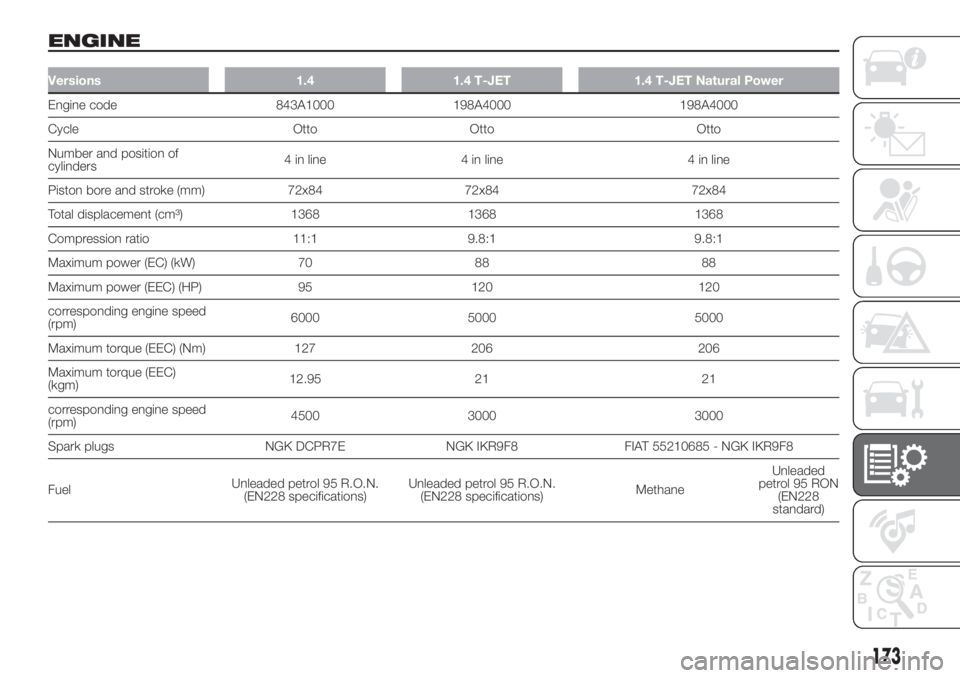
ENGINE
Versions 1.4 1.4 T-JET 1.4 T-JET Natural Power
Engine code 843A1000 198A4000 198A4000
Cycle Otto Otto Otto
Number and position of
cylinders4 in line 4 in line 4 in line
Piston bore and stroke (mm) 72x84 72x84 72x84
Total displacement (cm³) 1368 1368 1368
Compression ratio 11:1 9.8:1 9.8:1
Maximum power (EC) (kW) 70 88 88
Maximum power (EEC) (HP) 95 120 120
corresponding engine speed
(rpm)6000 5000 5000
Maximum torque (EEC) (Nm) 127 206 206
Maximum torque (EEC)
(kgm)12.95 21 21
corresponding engine speed
(rpm)4500 3000 3000
Spark plugs NGK DCPR7E NGK IKR9F8 FIAT 55210685 - NGK IKR9F8
FuelUnleaded petrol 95 R.O.N.
(EN228 specifications)Unleaded petrol 95 R.O.N.
(EN228 specifications)MethaneUnleaded
petrol 95 RON
(EN228
standard)
173
Page 176 of 272
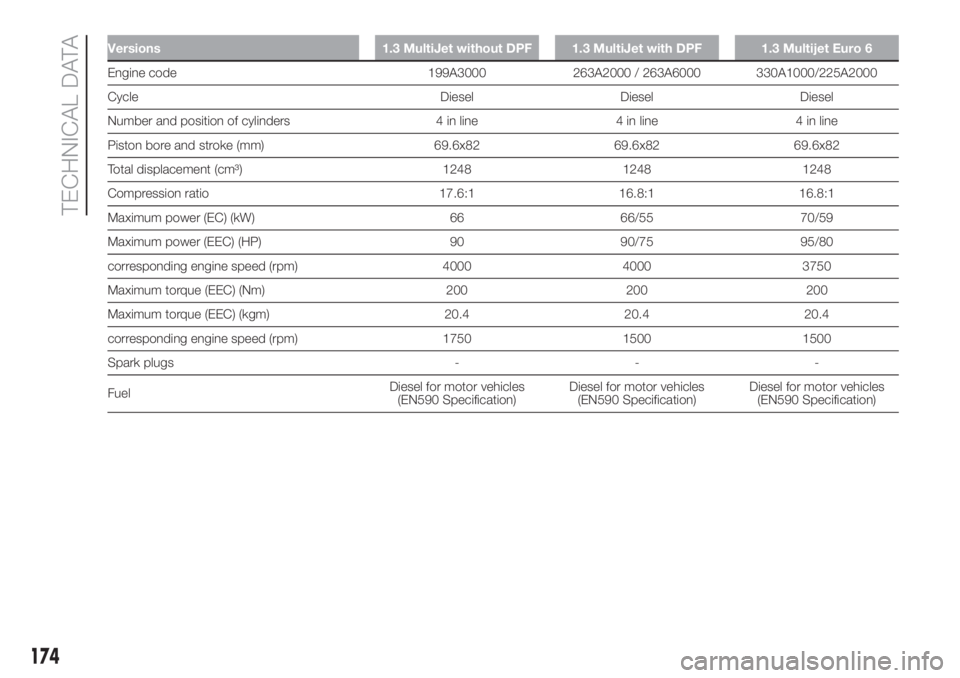
Versions 1.3 MultiJet without DPF 1.3 MultiJet with DPF 1.3 Multijet Euro 6
Engine code 199A3000 263A2000 / 263A6000 330A1000/225A2000
Cycle Diesel Diesel Diesel
Number and position of cylinders 4 in line 4 in line 4 in line
Piston bore and stroke (mm) 69.6x82 69.6x82 69.6x82
Total displacement (cm³) 1248 1248 1248
Compression ratio 17.6:1 16.8:1 16.8:1
Maximum power (EC) (kW) 66 66/55 70/59
Maximum power (EEC) (HP) 90 90/75 95/80
corresponding engine speed (rpm) 4000 4000 3750
Maximum torque (EEC) (Nm) 200 200 200
Maximum torque (EEC) (kgm) 20.4 20.4 20.4
corresponding engine speed (rpm) 1750 1500 1500
Spark plugs - - -
FuelDiesel for motor vehicles
(EN590 Specification)Diesel for motor vehicles
(EN590 Specification)Diesel for motor vehicles
(EN590 Specification)
174
TECHNICAL DATA
Page 177 of 272
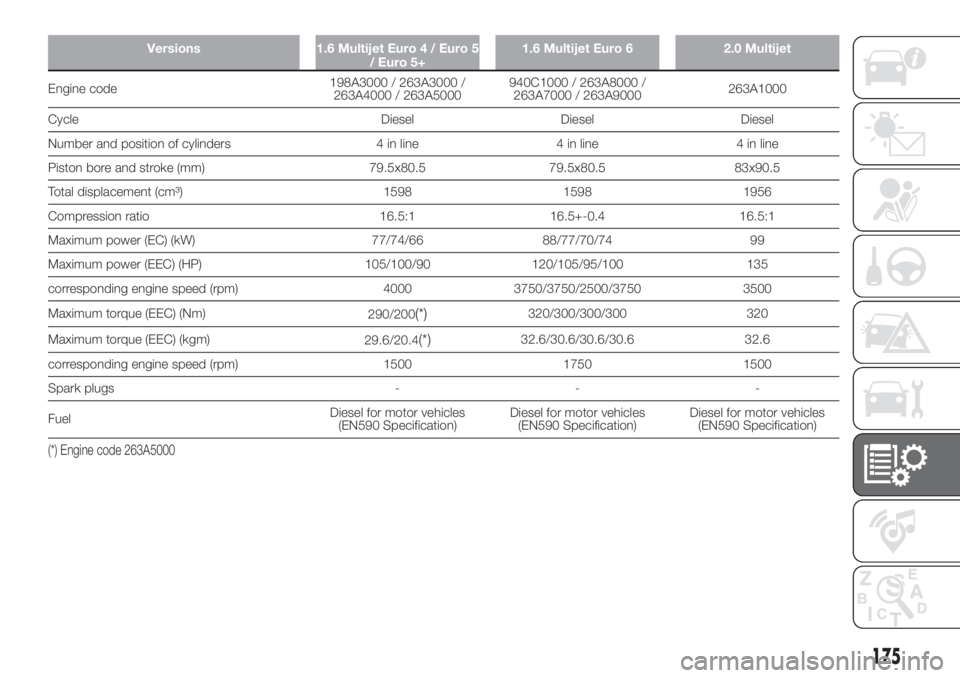
Versions 1.6 Multijet Euro 4 / Euro 5
/ Euro 5+1.6 Multijet Euro 6 2.0 Multijet
Engine code198A3000 / 263A3000 /
263A4000 / 263A5000940C1000 / 263A8000 /
263A7000 / 263A9000263A1000
Cycle Diesel Diesel Diesel
Number and position of cylinders 4 in line 4 in line 4 in line
Piston bore and stroke (mm) 79.5x80.5 79.5x80.5 83x90.5
Total displacement (cm³) 1598 1598 1956
Compression ratio 16.5:1 16.5+-0.4 16.5:1
Maximum power (EC) (kW) 77/74/66 88/77/70/74 99
Maximum power (EEC) (HP) 105/100/90 120/105/95/100 135
corresponding engine speed (rpm) 4000 3750/3750/2500/3750 3500
Maximum torque (EEC) (Nm)
290/200
(*)320/300/300/300 320
Maximum torque (EEC) (kgm)
29.6/20.4
(*)32.6/30.6/30.6/30.6 32.6
corresponding engine speed (rpm) 1500 1750 1500
Spark plugs - - -
FuelDiesel for motor vehicles
(EN590 Specification)Diesel for motor vehicles
(EN590 Specification)Diesel for motor vehicles
(EN590 Specification)
(*) Engine code 263A5000
175